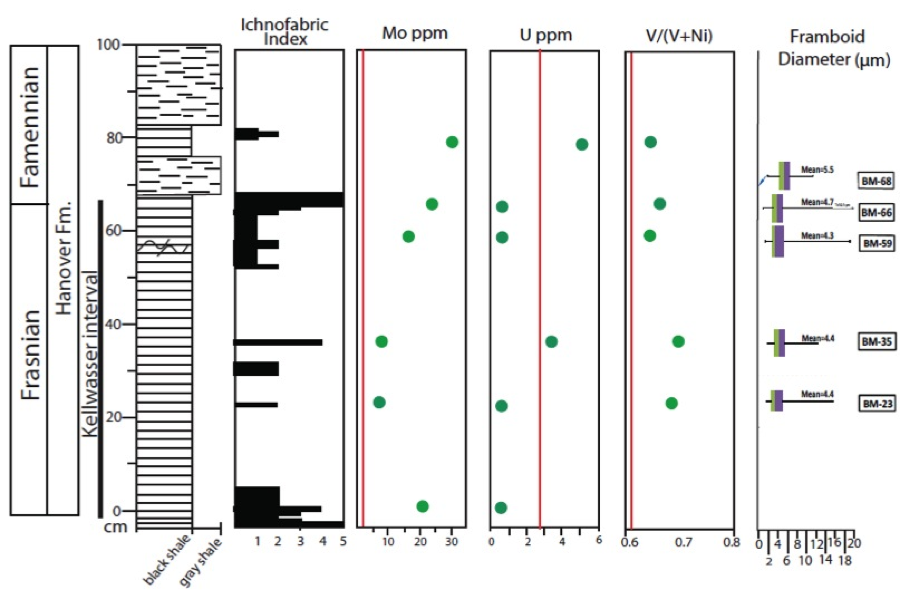www.acsprf.org
Reports: UNI850400-UNI8: Testing the Extent of Anoxia in Late Devonian Aged Black Shales: A Multi-proxy Approach
Diana L. Boyer, PhD , State University of New York, at Oswego
Boyer Progress report: Narrative
During the first year of this granting period much work has been undertaken towards understanding the dynamics of bottom water oxygen levels in association with extinction events. This initial year focused on collecting a representative samples at a range of scales and completing preliminary trace fossil, geochemical and pyrite framboid analysis. Five undergraduate students were involved in field and lab work which has resulted in one field trip guidebook for the New York State Geological Association (Boyer and Wooton, in press) and a poster to be presented at the annual Geological Society of America meeting this fall (Boyer and Wilcox, 2011), but importantly lay the foundation for detailed characterization of Devonian low oxygen intervals associated with biotic turnover. The details of this work are outlined below.
Field Work
During the first field season (Aug 2010), localities were assessed for utility in this project and initial samples were collected. A total of 8 localities (Fig. 1) in western New York were investigated with students (Wilcox and Collins) and resulted in the collection of over 100 samples in and around the Frasnian/Famennian (F/F) boundary in the Pipe Creek, Hanover and Dunkirk Formations. This boundary is associated with the Upper Kellwassser Event and one of the largest extinction events in the history of life (). These intervals were targeted for first study because of they are associated with the largest biotic turnover addressed in this study and were intended to establish an end member for comparison with other biotic turnovers preserved in black shales. Samples were collected on a coarse scale (meter) leading up to and overlying the extinction event, at each locality, but at higher resolution in and around the boundary interval.
 |
Figure 1. Field localities divided by formation exposure.
The second field season (Summer 2011) resulted in high-resolution sampling of intervals surrounding the F/F boundary (Upper Kellwasser Event) and the Lower Kellwasser event, as well as reconnaissance work to establish accessible and appropriate localities to evaluate other biotic turnovers. Samples were collected continuously (mm scale) with overlapping samples through over 8 meters of section at 3 localities capturing the upper Kellwasser Event, 2 localities that preserve the lower Kellwasser Event and 5 other localities at a coarser scale that preserved the Upper Devonian Middlesex and Rhinestreet and Genesseo Shales. This field work was greatly aided by the help of an undergraduate student (Seeger).
Laboratory Processing of Samples
Samples collected during the first field season were cut perpendicular to bedding to reveal ichnofabric. Details of the relative amount of bioturbation as ichnofabric index (Droser and Bottjer, 1986), size of individual burrows and sedimentary features, such as descriptions of laminations, presence of ripples, grading or scour, were recorded in detail. Samples were scanned to digitally capture features.
In association with the trace fossil and sedimentological data, samples were powdered for whole rock geochemical analysis. Student Wilcox did much of the lab procedures using the ICPMS in the Interdisciplinary Elemental Measurement Faculty at SUNY Oswego. Standard methodologies were used to determine whole rock trace metal compositions for 80 samples.
Pyrite framboid size data was collected for 8 samples this summer with the help of a student (Spath). Characteristics of framboid assemblages have been recognized as proxy for bottom water oxygen conditions. Using Scanning Electron Microscopy (SEM) housed at the SUNY-ESF N.C. Brown Center for Ultrastructure facilities. More pyrite framboid data is expected from the newly acquired SEM that has just arrive on the campus of SUNY Oswego, and will likely be more efficient in capturing back-scatter emission images.
Initial results
Data from all of the sampled localities that have been examined in detail support that there was oxygen stress at this time and that conditions were periodically, but not persistently, anoxic through the Kellwasser Event in New York State. Ichnofabric index (ii) values ranging from 1-5 (laminated through fully bioturbated) indicating a wide range of relative bottom water oxygen levels. Variation between ichnofabric values occur over a very short stratigraphic interval, for example a shift from ii 1 to ii 5 over 3 cm (Fig 2). Trace metal values support dysoxic, but not preserve a strongly anoxic or euxinic signal; however, values are variable within and between sections and require higher resolution sampling for more precise nterpretation. The pyrite framboid assmeblages also show a range of mean values that correlate in concert with ii values, and therefore, inferred relative oxygen levels, but also do not support persistent anoxic depositional conditions.
Figure 2. Results from Beaver Meadow Creek through the Kellwasser interval show variable ichnofabric values, trace metal values and variation in pyrite framboid populations, notably mean values that are variable.
Future work
Work is currently underway to continue characterize in detail the dynamic bottom water conditions through the Upper Kellwasser event. A novel technique for isolating pyrite framboids for analysis is currently being explored. Also samples will be taken for geochemical trace metal analysis continuously (every cm) through the Kellwasser interval from at least three localities. Initial preparation and analysis of samples from the Geneseo, Middlesex, and Rhinestreet shales will allow further extrapolation of bottom water oxygen conditions associated with different biotic crises in the rock record.
Boyer, D.L. and Wilcox, 2011, Dynamic paleoredox signal preserved in the Kellwasser Interval of New York State, Geological Society of America Abstracts with Programs, Vol. 43, No. 5, p. 259
Boyer, D.L. and Wooton, E., in press, Paleoecology of black and gray shales of central New York, New York State Geological Association Guidebook.

